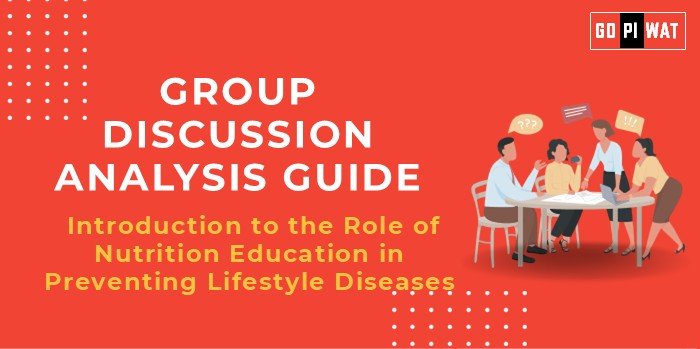📋 Group Discussion Analysis Guide
🌐 Introduction to the Role of Nutrition Education in Preventing Lifestyle Diseases
Nutrition education plays a critical role in public health strategies, especially in combating lifestyle diseases like diabetes, which affects
537 million adults globally (IDF, 2021).
With rapid urbanization, sedentary lifestyles, and unhealthy eating patterns, the prevalence of diabetes has risen sharply. Nutrition education is a key intervention to address these issues at both individual and community levels.
📊 Quick Facts and Key Statistics
- Global Diabetes Prevalence: 10.5% of the adult population worldwide (2021) – highlighting the urgent need for prevention strategies.
- India’s Burden: 77 million adults with diabetes, expected to rise to 134 million by 2045.
- Economic Impact: $966 billion spent globally on diabetes management annually (IDF, 2021).
- Diet-Linked Cases: Studies suggest up to 80% of Type 2 diabetes cases are preventable through lifestyle changes, including nutrition.
👥 Stakeholders and Their Roles
- Government: Implement national nutrition policies and public awareness campaigns.
- Healthcare Providers: Educate patients about healthy dietary choices during consultations.
- Educational Institutions: Integrate nutrition education into school and college curriculums.
- Non-Governmental Organizations (NGOs): Conduct grassroots campaigns to promote awareness.
- Food Industry: Develop and market healthier food options.
🏆 Achievements and Challenges
Achievements:
- Policy Success: India’s Eat Right Movement by FSSAI.
- Community Initiatives: Kerala’s Kudumbashree promoted healthy eating habits, reducing diabetes rates locally.
- School Interventions: Programs like mid-day meals focusing on balanced nutrition.
Challenges:
- Lack of Awareness: Among vulnerable populations.
- Economic Barriers: High cost and limited availability of nutritious food.
- Influence of Advertising: Processed food marketing particularly targets youth.
Global Comparisons:
- Japan: Low diabetes rates due to traditional diets and early health education.
- USA: Community-based nutrition education has shown moderate success in low-income areas.
Case Study: Tamil Nadu’s community kitchens offering diabetes-friendly diets.
📂 Structured Arguments for Discussion
- Supporting Stance: “Empowering people with knowledge about nutrition can prevent up to 80% of Type 2 diabetes cases.”
- Opposing Stance: “Nutrition education alone cannot offset genetic predispositions or the influence of modern lifestyles.”
- Balanced Perspective: “While nutrition education is vital, systemic changes like affordable access to healthy food are equally important.”
✨ Effective Discussion Approaches
Opening Approaches:
- Statistics: “Every 10 seconds, someone dies from diabetes-related complications globally.”
- Success Story: Kerala’s nutrition-focused health reforms.
- Rhetorical Question: “Can a simple diet change prevent a lifetime of diabetes medication?”
Counter-Argument Handling:
- Acknowledge economic barriers to healthy eating.
- Suggest practical solutions like subsidizing healthy foods or tax incentives for wellness programs.
🔍 Strategic Analysis of Strengths and Weaknesses
- Strengths: Cost-effective prevention, promotes long-term health.
- Weaknesses: Requires consistent reinforcement and behavior change.
- Opportunities: Integration with digital health platforms for broader reach.
- Threats: Resistance from vested interests in the processed food industry.
📚 Connecting with B-School Applications
- Real-World Applications: Linking nutrition education to operations (e.g., supply chain for healthier foods) and development projects.
- Sample Interview Questions:
- “How can corporate wellness programs incorporate nutrition education effectively?”
- “What role does the food industry play in combating diabetes?”
- Insights for B-School Students:
- Innovative marketing strategies for healthy foods.
- Social entrepreneurship opportunities in nutrition education.


